Abstract
Tumor angiogenesis factor (TAF) and its importance in determining a strategy for cancer chemotherapy are discussed. It is suggested that inhibition of RNA synthesis or increased RNA catabolism might interfere with the metabolism of solid tumor cells more so than in normal cells, and thus hinder angiogenesis and pursuant tumor growth by preventing the synthesis of the RNA component of TAF. An attempt is made to indicate potential models for anti-angiogenesis agents of this type. The drugs offered as initial prototypes for investigations along these lines are actinomycin D (which likely has antimetabolite and anti-angiogenesis activities), polyriboinosinic-polyribocytidylic acid (which likely has adjuvant and anti-angiogenesis activities) and ribonuclease (which in theory might be a purely anti-angiogenetic agent). It is noted that these models may turn out to be less than ideal as therapeutic agents due to problems of toxicity, metabolism, potency, or distribution, but nonetheless might serve to yield insights into the design of new cancer chemotherapeutic drugs. In addition, some evidence is cited suggesting that actinomycin D may be more effective against certain tumors when employed in lower, chronic dosages rather than its present use in “loading” dosages.
The concept of anti-angiogenesis agents as fundamentally “tumoristatic” therapies is discussed, and the likelihood that such agents might be effectively “tumoricidal” in immunocompetent hosts is mentioned. The main promise of an anti-angiogenetic strategy is efficacy against presently intractable slowly growing human cancers when used in combination with other treatment modalities. In summary, a strategy of cancer chemotherapy predicated upon interference with RNA synthesis or increase in RNA catabolism is offered as a potential mechanism for establishing anti-angiogenesis, and as a promising alternative and adjunct to present methods.
Full text
PDF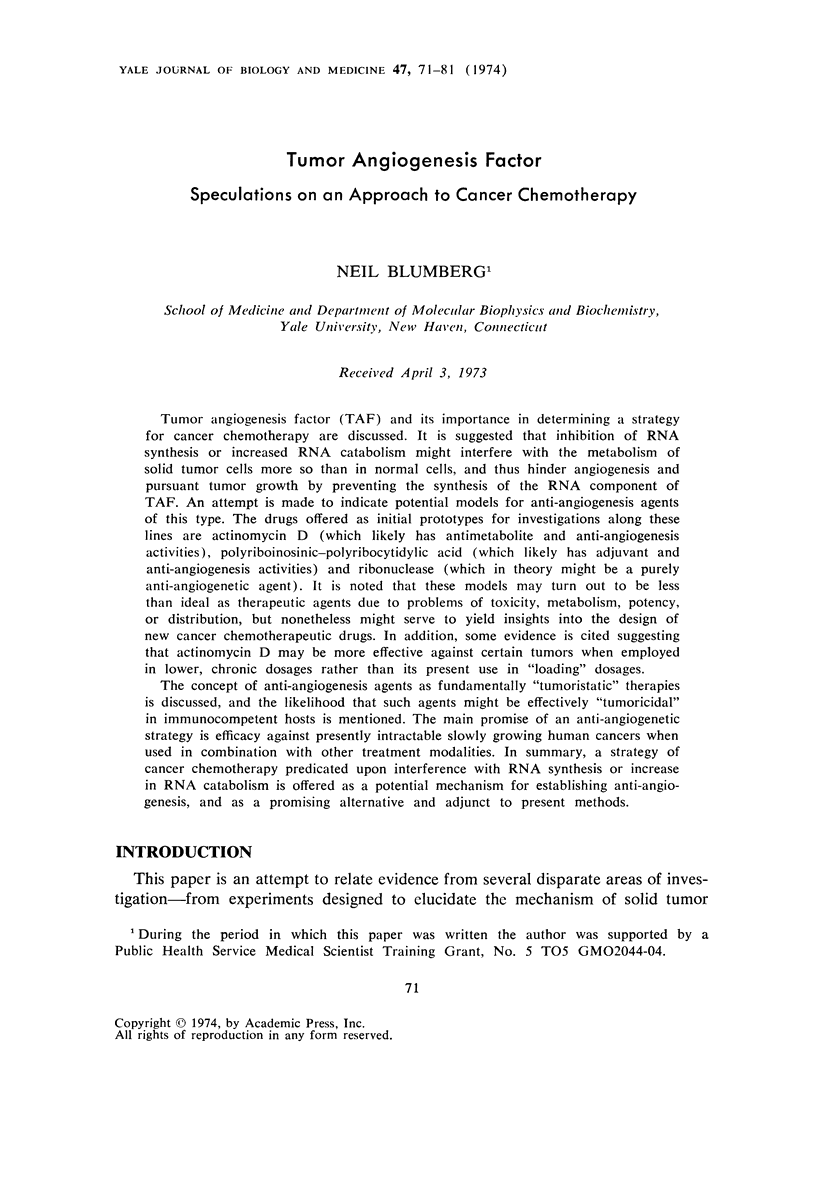
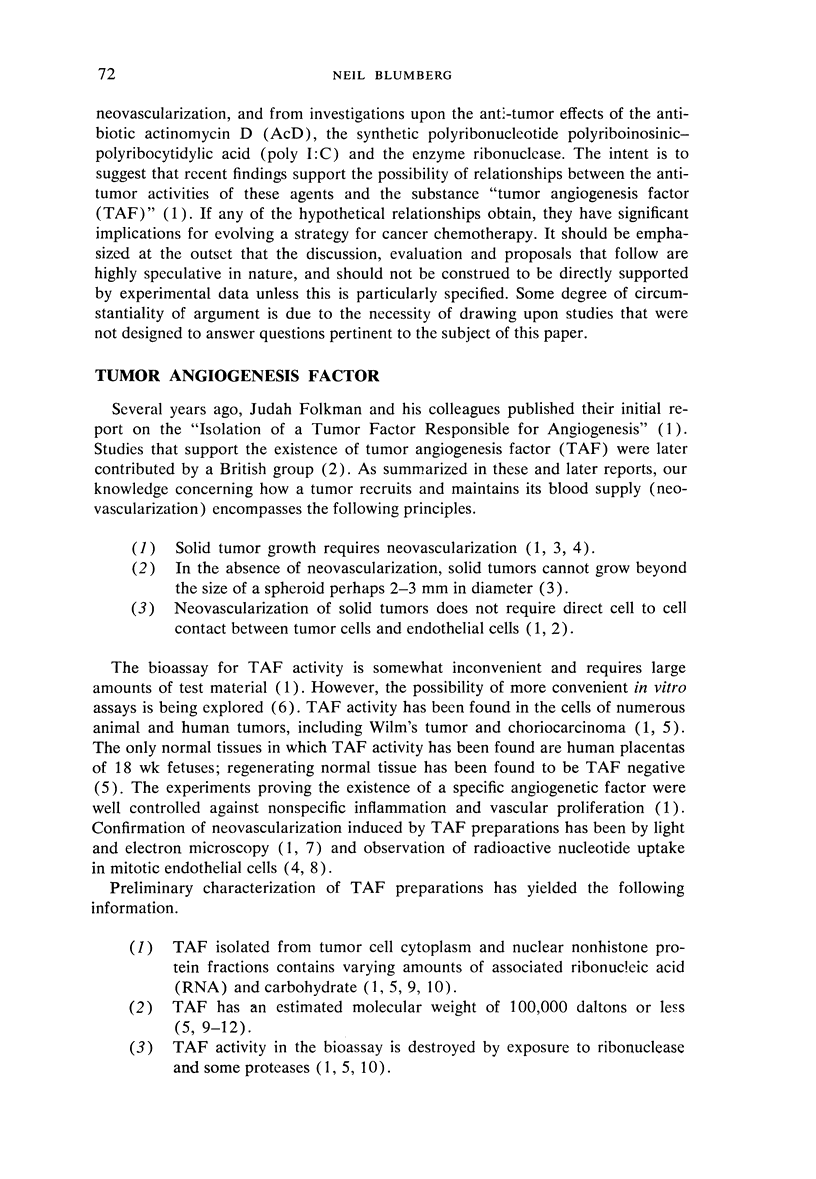
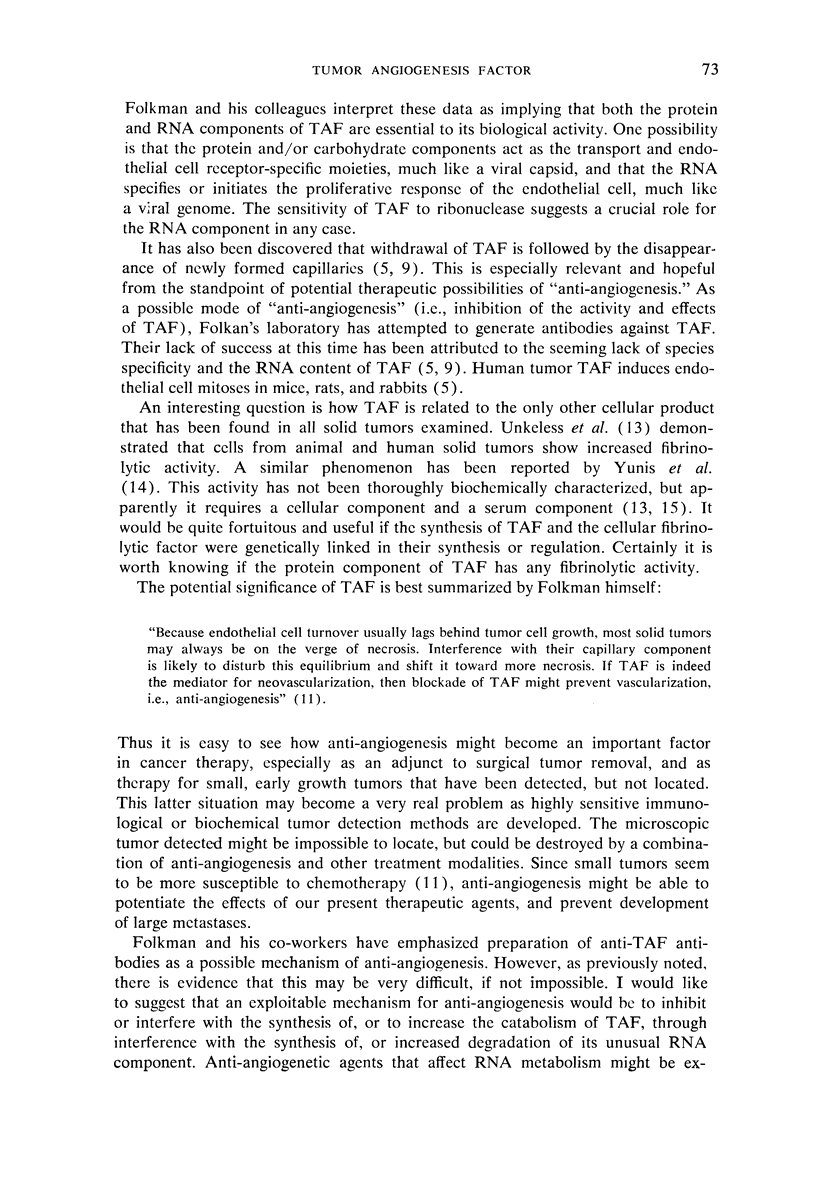
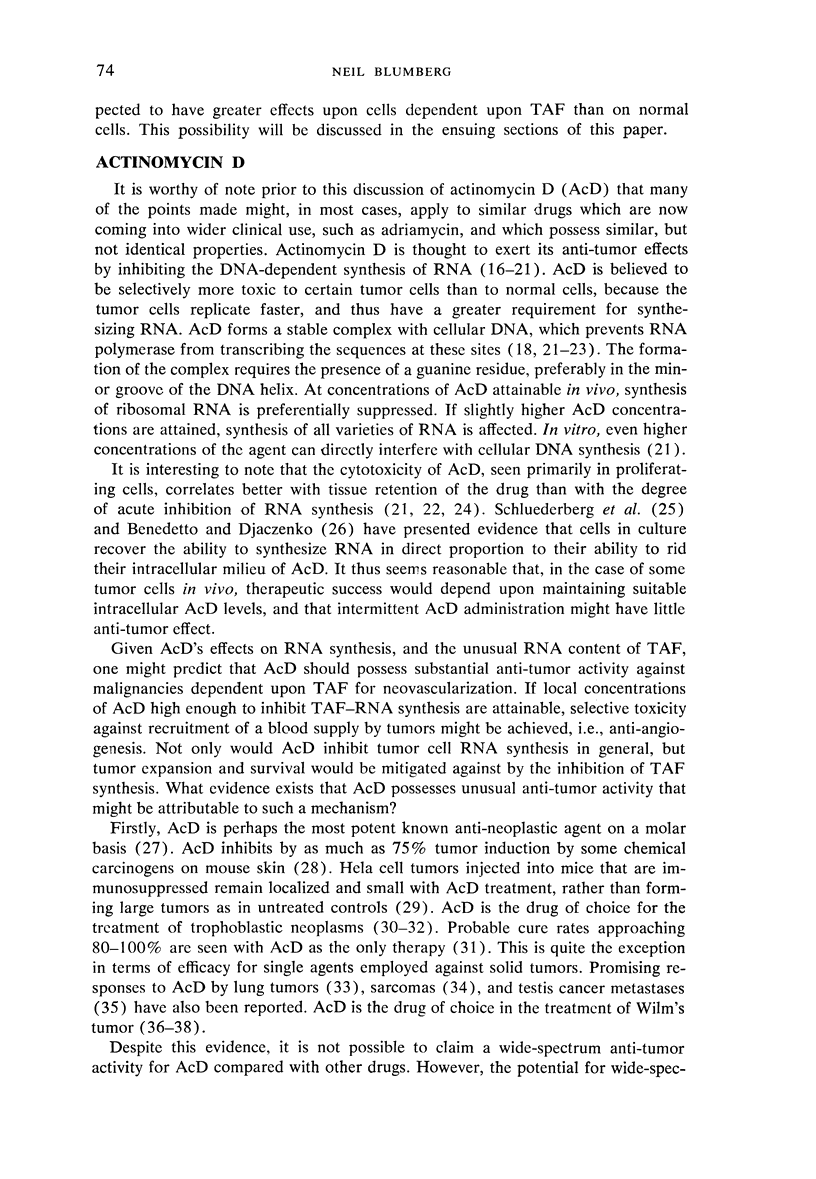
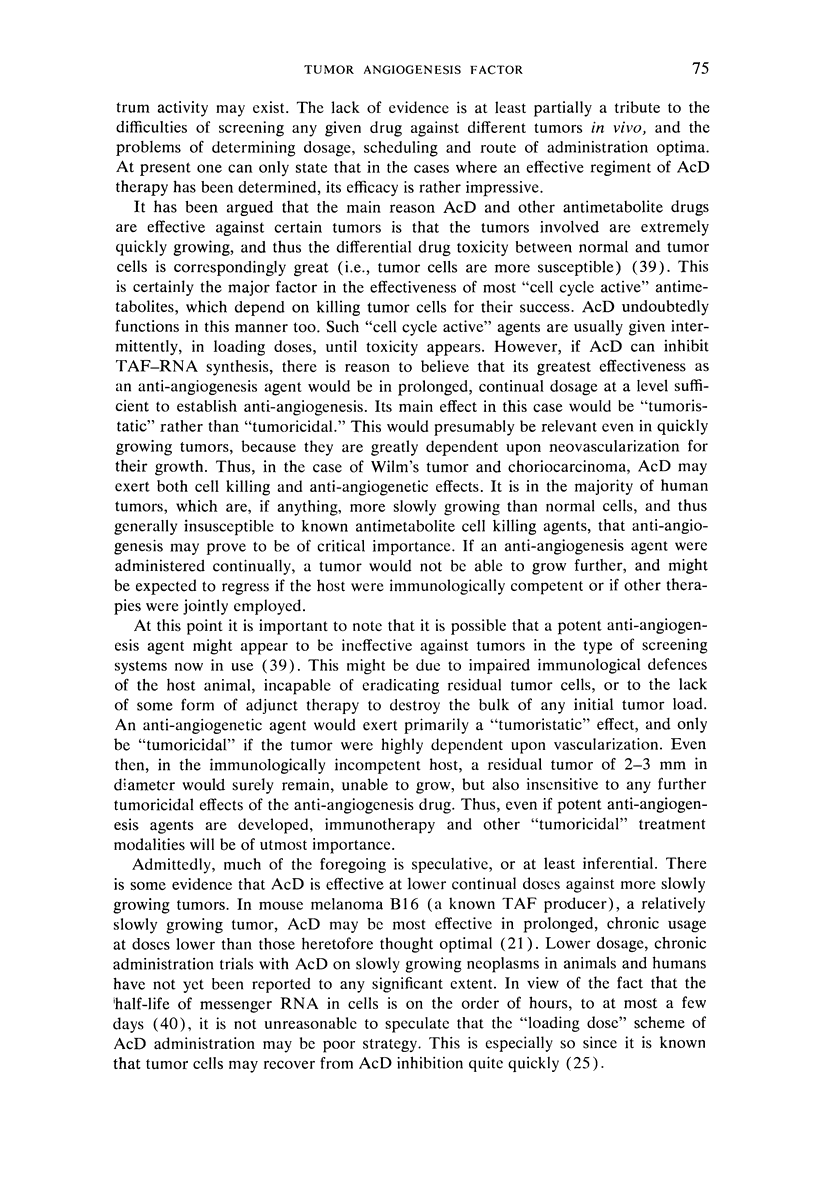
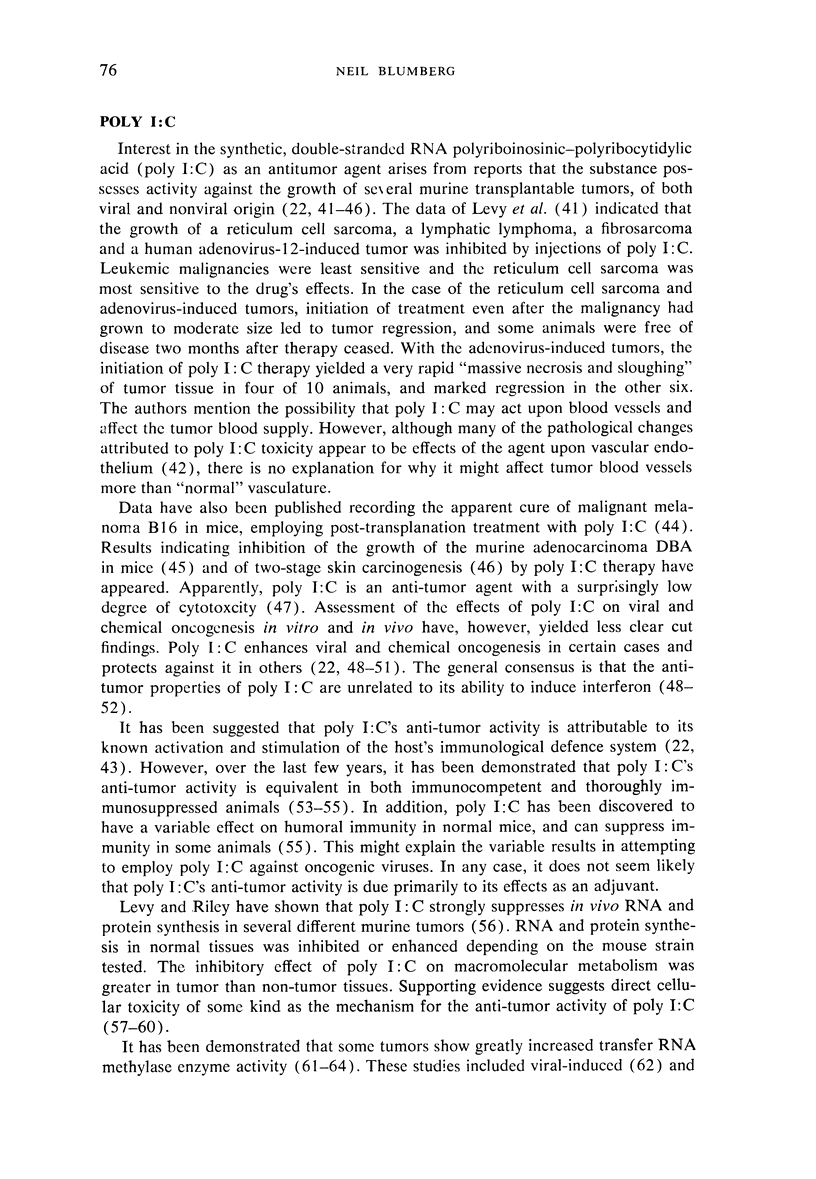
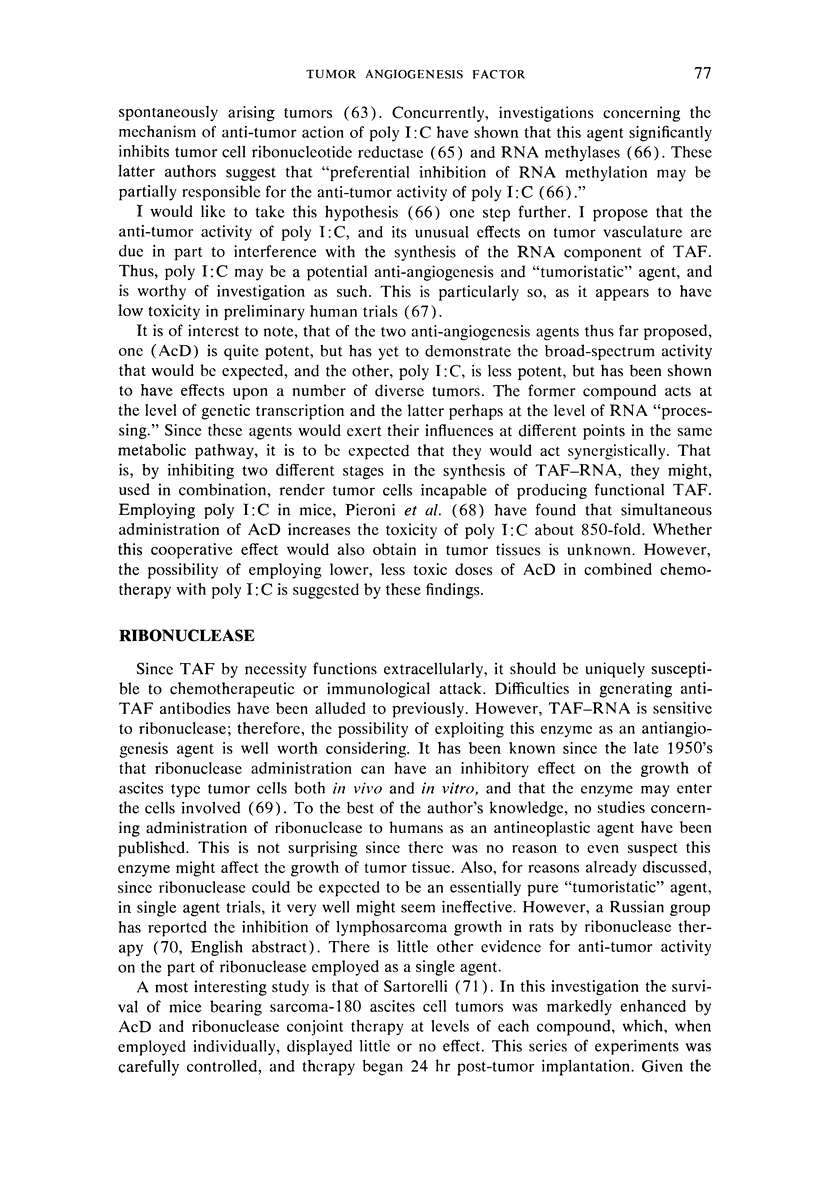
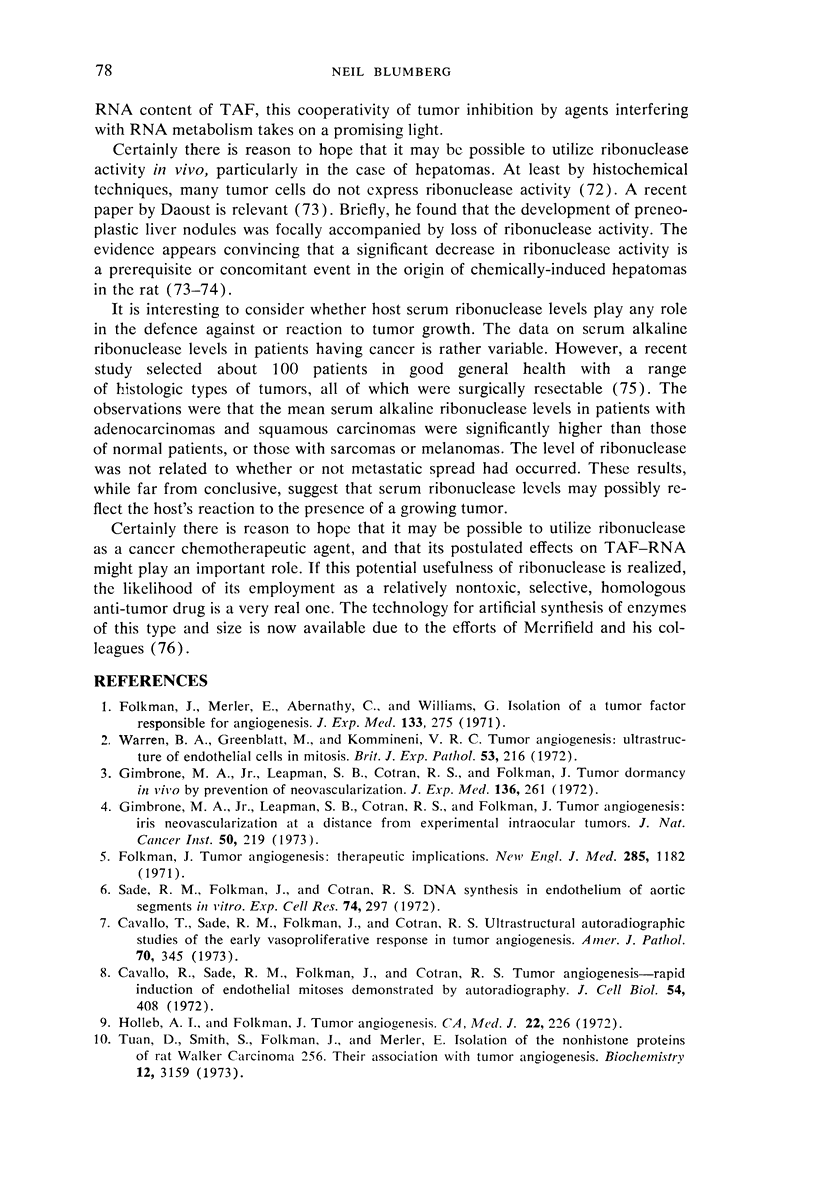
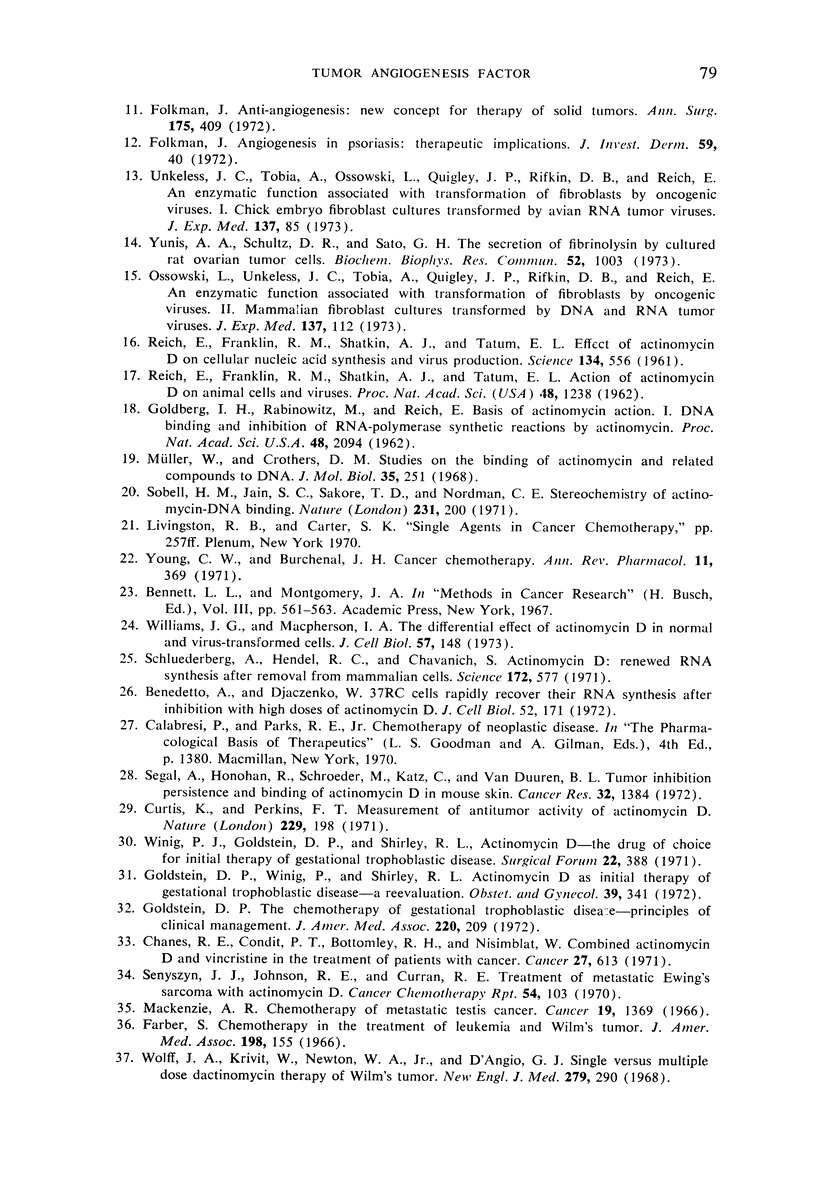
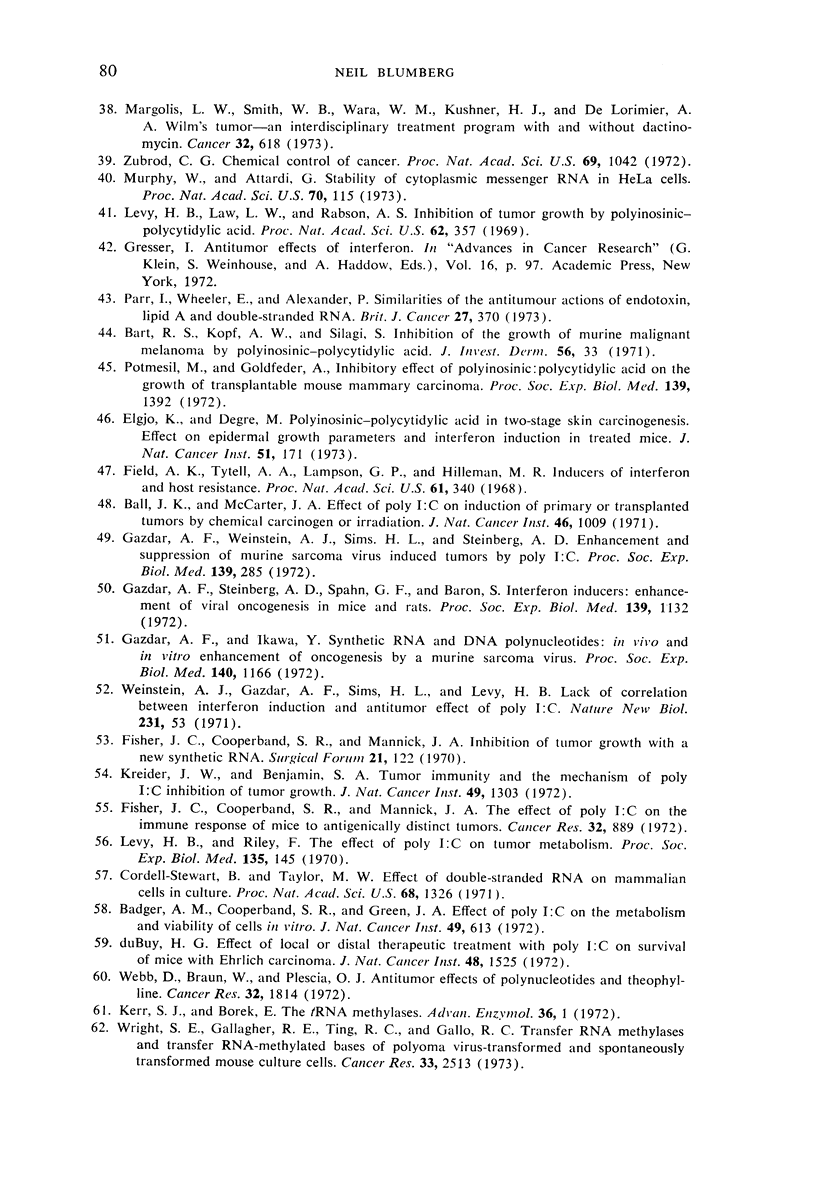
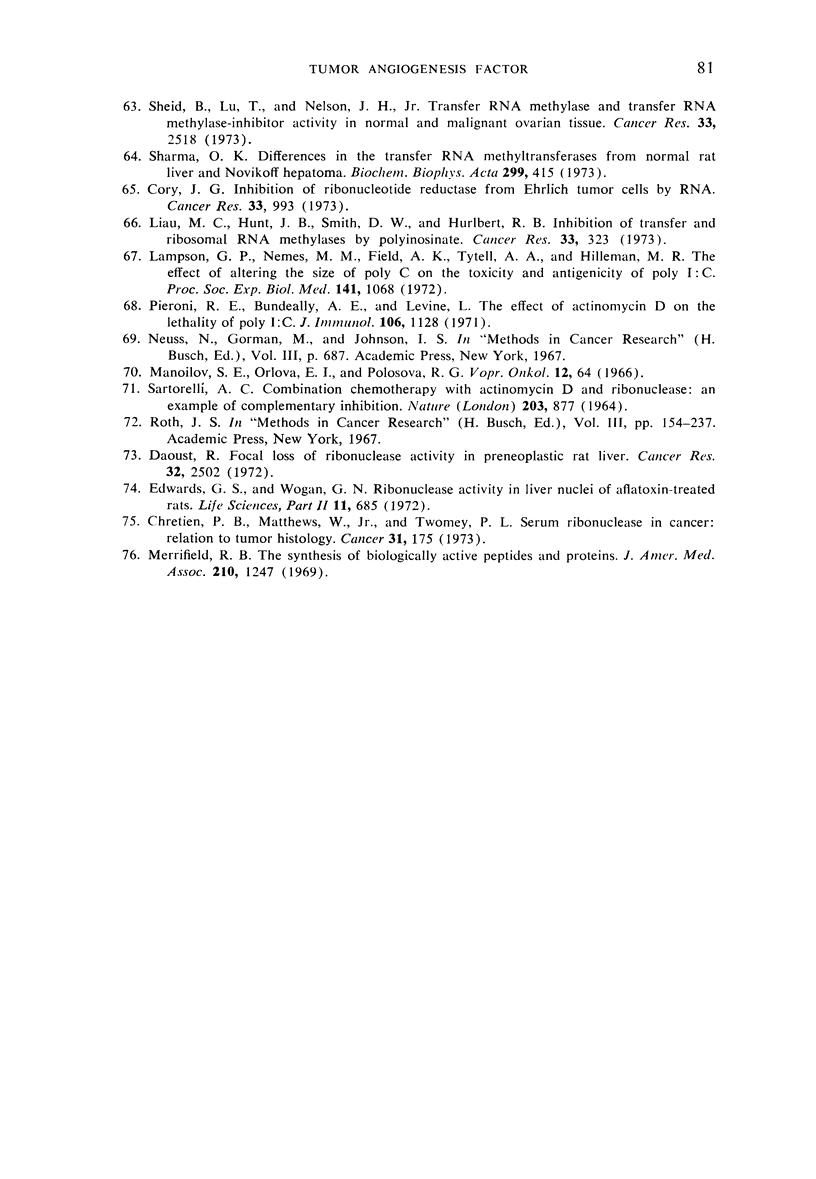
Selected References
These references are in PubMed. This may not be the complete list of references from this article.
- Badger A. M., Cooperband S. R., Green J. A. Effect of polyriboinosinic-polyribocytidylic acid on the metabolism and viability of cells in vitro. J Natl Cancer Inst. 1972 Sep;49(3):613–621. [PubMed] [Google Scholar]
- Ball J. K., McCarter J. A. Effect of polyinosinic-polycytidylic acid on induction of primary or transplanted tumors by chemical carcinogen or irradiation. J Natl Cancer Inst. 1971 May;46(5):1009–1014. [PubMed] [Google Scholar]
- Benedetto A., Djaczenko W. 37RC cells rapidly recover their RNA synthesis after inhibition with high doses of actinomycin D. J Cell Biol. 1972 Jan;52(1):171–174. doi: 10.1083/jcb.52.1.171. [DOI] [PMC free article] [PubMed] [Google Scholar]
- Cavallo T., Sade R., Folkman J., Cotran R. S. Tumor angiogenesis. Rapid induction of endothelial mitoses demonstrated by autoradiography. J Cell Biol. 1972 Aug;54(2):408–420. doi: 10.1083/jcb.54.2.408. [DOI] [PMC free article] [PubMed] [Google Scholar]
- Cavallo T., Sade R., Folkman J., Cotran R. S. Ultrastructural autoradiographic studies of the early vasoproliferative response in tumor angiogenesis. Am J Pathol. 1973 Mar;70(3):345–362. [PMC free article] [PubMed] [Google Scholar]
- Chanes R. E., Condit P. T., Bottomley R. H., Nisimblat W. Combined actinomycin D and vincristine in the treatment of patients with cancer. Cancer. 1971 Mar;27(3):613–617. doi: 10.1002/1097-0142(197103)27:3<613::aid-cncr2820270316>3.0.co;2-w. [DOI] [PubMed] [Google Scholar]
- Chretien P. B., Matthews W., Jr, Twomey P. L. Serum ribonucleases in cancer: relation to tumor histology. Cancer. 1973 Jan;31(1):175–179. doi: 10.1002/1097-0142(197301)31:1<175::aid-cncr2820310124>3.0.co;2-c. [DOI] [PubMed] [Google Scholar]
- Cordell-Stewart B., Taylor M. W. Effect of double-stranded viral RNA on mammalian cells in culture. Proc Natl Acad Sci U S A. 1971 Jun;68(6):1326–1330. doi: 10.1073/pnas.68.6.1326. [DOI] [PMC free article] [PubMed] [Google Scholar]
- Cory J. G. Inhibition of ribonucleotide reductase from Ehrlich tumor cells by RNA. Cancer Res. 1973 May;33(5):993–998. [PubMed] [Google Scholar]
- Curtis K., Perkins F. T. Measurement of antitumour activity of actinomycin D. Nature. 1971 Jan 15;229(5281):198–199. doi: 10.1038/229198a0. [DOI] [PubMed] [Google Scholar]
- Daoust R. Focal loss of ribonuclease activity in preneoplastic rat liver. Cancer Res. 1972 Nov;32(11):2502–2509. [PubMed] [Google Scholar]
- DuBuy H. G. Effect of local or distal therapeutic treatment with polyinosinic-polycytidylic acid on survival of mice with Ehrlich carcinoma. J Natl Cancer Inst. 1972 May;48(5):1525–1527. [PubMed] [Google Scholar]
- Edwards G. S., Wogan G. N. Ribonuclease activity in liver nuclei of aflatoxin-treated rats. Life Sci II. 1972 Jul 22;11(14):685–689. doi: 10.1016/0024-3205(72)90051-3. [DOI] [PubMed] [Google Scholar]
- Elgio K., Degŕe M. Polyinosinic-polycytidylic acid in two-stage skin carcinogenesis. Effect on epidermal growth parameters and interferon induction in treated mice. J Natl Cancer Inst. 1973 Jul;51(1):171–177. doi: 10.1093/jnci/51.1.171. [DOI] [PubMed] [Google Scholar]
- Field A. K., Tytell A. A., Lampson G. P., Hilleman M. R. Inducers of interferon and host resistance, V. In vitro studies. Proc Natl Acad Sci U S A. 1968 Sep;61(1):340–346. doi: 10.1073/pnas.61.1.340. [DOI] [PMC free article] [PubMed] [Google Scholar]
- Fisher J. C., Cooperband S. R., Mannick J. A. Inhibition of tumor growth with a new synthetic ribonucleic acid. Surg Forum. 1970;21:122–124. [PubMed] [Google Scholar]
- Fisher J. C., Cooperband S. R., Mannick J. A. The effect of polyinosinic-polycytidylic acid on the immune response of mice to antigenically distinct tumors. Cancer Res. 1972 May;32(5):889–892. [PubMed] [Google Scholar]
- Folkman J. Anti-angiogenesis: new concept for therapy of solid tumors. Ann Surg. 1972 Mar;175(3):409–416. doi: 10.1097/00000658-197203000-00014. [DOI] [PMC free article] [PubMed] [Google Scholar]
- Folkman J., Merler E., Abernathy C., Williams G. Isolation of a tumor factor responsible for angiogenesis. J Exp Med. 1971 Feb 1;133(2):275–288. doi: 10.1084/jem.133.2.275. [DOI] [PMC free article] [PubMed] [Google Scholar]
- GOLDBERG I. H., RABINOWITZ M., REICH E. Basis of actinomycin action. I. DNA binding and inhibition of RNA-polymerase synthetic reactions by actinomycin. Proc Natl Acad Sci U S A. 1962 Dec 15;48:2094–2101. doi: 10.1073/pnas.48.12.2094. [DOI] [PMC free article] [PubMed] [Google Scholar]
- Gazdar A. F., Ikawa Y. Synthetic RNA and DNA polynucleotides: in vivo and in vitro enhancement of oncogenesis by a murine sarcoma virus. Proc Soc Exp Biol Med. 1972 Sep;140(4):1166–1169. doi: 10.3181/00379727-140-36633. [DOI] [PubMed] [Google Scholar]
- Gazdar A. F., Steinberg A. D., Spahn G. F., Baron S. Interferon inducers: enhancement of viral oncogenesis in mice and rats. Proc Soc Exp Biol Med. 1972 Apr;139(4):1132–1137. doi: 10.3181/00379727-139-36314. [DOI] [PubMed] [Google Scholar]
- Gazdar A. F., Weinstein A. J., Sims H. L., Steinberg A. D. Enhancement and suppression of murine sarcoma virus induced tumors by polyriboinosinic-polyribocytidylic acid. Proc Soc Exp Biol Med. 1972 Jan;139(1):279–285. doi: 10.3181/00379727-139-36126. [DOI] [PubMed] [Google Scholar]
- Gimbrone M. A., Jr, Leapman S. B., Cotran R. S., Folkman J. Tumor angiogenesis: iris neovascularization at a distance from experimental intraocular tumors. J Natl Cancer Inst. 1973 Jan;50(1):219–228. doi: 10.1093/jnci/50.1.219. [DOI] [PubMed] [Google Scholar]
- Gimbrone M. A., Jr, Leapman S. B., Cotran R. S., Folkman J. Tumor dormancy in vivo by prevention of neovascularization. J Exp Med. 1972 Aug 1;136(2):261–276. doi: 10.1084/jem.136.2.261. [DOI] [PMC free article] [PubMed] [Google Scholar]
- Goldstein D. P. The chemotherapy of gestational trophoblastic disease: principles of clinical management. JAMA. 1972 Apr 10;220(2):209–213. [PubMed] [Google Scholar]
- Goldstein D. P., Winig P., Shirley R. L. Actinomycin D as initial therapy of gestational trophoblastic disease. A reevaluation. Obstet Gynecol. 1972 Mar;39(3):341–345. [PubMed] [Google Scholar]
- Kreider J. W., Benjamin S. A. Tumor immunity and the mechanism of polyinosinic-polycytidylic acid inhibition of tumor growth. J Natl Cancer Inst. 1972 Nov;49(5):1303–1310. [PubMed] [Google Scholar]
- Lampson G. P., Nemes M. M., Field A. K., Tytell A. A., Hilleman M. R. The effect of altering the size of poly C on the toxicity and antigenicity of poly I:C. Proc Soc Exp Biol Med. 1972 Dec;141(3):1068–1072. doi: 10.3181/00379727-141-36934. [DOI] [PubMed] [Google Scholar]
- Levy H. B., Law L. W., Rabson A. S. Inhibition of tumor growth by polyinosinic-polycytidylic acid. Proc Natl Acad Sci U S A. 1969 Feb;62(2):357–361. doi: 10.1073/pnas.62.2.357. [DOI] [PMC free article] [PubMed] [Google Scholar]
- Levy H. B., Riley F. The effect of polyinosinic:polycytidylic acid on tumor metabolism. Proc Soc Exp Biol Med. 1970 Oct;135(1):141–145. doi: 10.3181/00379727-135-35006. [DOI] [PubMed] [Google Scholar]
- Liau M. C., Hunt J. B., Smith D. W., Hurlbert R. B. Inhibition of transfer and ribosomal RNA methylases by polyinosinate. Cancer Res. 1973 Feb;33(2):323–331. [PubMed] [Google Scholar]
- Mackenzie A. R. Chemotherapy of metastatic testis cancer. Results in 154 patients. Cancer. 1966 Oct;19(10):1369–1376. doi: 10.1002/1097-0142(196610)19:10<1369::aid-cncr2820191006>3.0.co;2-m. [DOI] [PubMed] [Google Scholar]
- Margolis L. W., Smith W. B., Wara W. M., Kushner J. H., DeLorimier A. A. Wilms' tumor--an interdisciplinary treatment program with and without dactinomycin. Cancer. 1973 Sep;32(3):618–622. doi: 10.1002/1097-0142(197309)32:3<618::aid-cncr2820320314>3.0.co;2-6. [DOI] [PubMed] [Google Scholar]
- Merrifield R. B. The synthesis of biologically active peptides and proteins. JAMA. 1969 Nov 17;210(7):1247–1254. [PubMed] [Google Scholar]
- Murphy W., Attardi G. Stability of cytoplasmic messenger RNA in HeLa cels. Proc Natl Acad Sci U S A. 1973 Jan;70(1):115–119. doi: 10.1073/pnas.70.1.115. [DOI] [PMC free article] [PubMed] [Google Scholar]
- Müller W., Crothers D. M. Studies of the binding of actinomycin and related compounds to DNA. J Mol Biol. 1968 Jul 28;35(2):251–290. doi: 10.1016/s0022-2836(68)80024-5. [DOI] [PubMed] [Google Scholar]
- Ossowski L., Unkeless J. C., Tobia A., Quigley J. P., Rifkin D. B., Reich E. An enzymatic function associated with transformation of fibroblasts by oncogenic viruses. II. Mammalian fibroblast cultures transformed by DNA and RNA tumor viruses. J Exp Med. 1973 Jan 1;137(1):112–126. doi: 10.1084/jem.137.1.112. [DOI] [PMC free article] [PubMed] [Google Scholar]
- Parr I., Wheeler E., Alexander P. Similarities of the anti-tumour actions of endotoxin, lipid A and double-stranded RNA. Br J Cancer. 1973 May;27(5):370–389. doi: 10.1038/bjc.1973.45. [DOI] [PMC free article] [PubMed] [Google Scholar]
- Pieroni R. E., Bundeally A. E., Levine L. The effect of actinomycin D on the lethality of poly I:C. J Immunol. 1971 Apr;106(4):1128–1129. [PubMed] [Google Scholar]
- Potmesil M., Goldfeder A. Inhibitory effect of polyinosinic:polycytidylic acid on the growth of transplantable mouse mammary carcinoma. Proc Soc Exp Biol Med. 1972 Apr;139(4):1392–1397. doi: 10.3181/00379727-139-36370. [DOI] [PubMed] [Google Scholar]
- REICH E., FRANKLIN R. M., SHATKIN A. J., TATUM E. L. Effect of actinomycin D on cellular nucleic acid synthesis and virus production. Science. 1961 Aug 25;134(3478):556–557. doi: 10.1126/science.134.3478.556. [DOI] [PubMed] [Google Scholar]
- REICH E., FRANKLIN R. M., SHATKIN A. J., TATUMEL Action of actinomycin D on animal cells and viruses. Proc Natl Acad Sci U S A. 1962 Jul 15;48:1238–1245. doi: 10.1073/pnas.48.7.1238. [DOI] [PMC free article] [PubMed] [Google Scholar]
- Sade R. M., Folkman J., Cotran R. S. DNA synthesis in endothelium of aortic segments in vitro. Exp Cell Res. 1972 Oct;74(2):297–306. doi: 10.1016/0014-4827(72)90380-1. [DOI] [PubMed] [Google Scholar]
- Schluederberg A., Hendel R. C., Chavanich S. Actinomycin D; renewed RNA synthesis after removal from mammalian cells. Science. 1971 May 7;172(3983):577–579. doi: 10.1126/science.172.3983.577. [DOI] [PubMed] [Google Scholar]
- Segal A., Honohan T., Schroeder M., Katz C., Van Duuren B. L. Tumor inhibition, persistence, and binding of actinomycin D in mouse skin. Cancer Res. 1972 Jul;32(7):1384–1390. [PubMed] [Google Scholar]
- Senyszyn J. J., Johnson R. E., Curran R. E. Treatment of metastatic Ewing's sarcoma with actinomycin D (NSC-3053). Cancer Chemother Rep. 1970 Apr;54(2):103–107. [PubMed] [Google Scholar]
- Sharma O. K. Differences in the transfer RNA methyltransferases from normal rat liver and Novikoff hepatoma. Biochim Biophys Acta. 1973 Mar 28;299(3):415–427. doi: 10.1016/0005-2787(73)90266-9. [DOI] [PubMed] [Google Scholar]
- Sheid B., Lu T., Nelson J. H., Jr Transfer RNA methylase and transfer RNA methylase-inhibitor activity in normal and malignant human ovarian tissue. Cancer Res. 1973 Oct;33(10):2518–2523. [PubMed] [Google Scholar]
- Sobell H. M., Jain S. C., Sakore T. D., Nordman C. E. Stereochemistry of actinomycin--DNA binding. Nat New Biol. 1971 Jun 16;231(24):200–205. doi: 10.1038/newbio231200a0. [DOI] [PubMed] [Google Scholar]
- Tuan D., Smith S., Folkman J., Merler E. Isolation of the nonhistone proteins of rat Walker carcinoma 256. Biochemistry. 1973 Aug 14;12(17):3159–3165. doi: 10.1021/bi00741a004. [DOI] [PubMed] [Google Scholar]
- Warren B. A., Greenblatt M., Kommineni V. R. Tumour angiogenesis: ultrastructure of endothelial cells in mitosis. Br J Exp Pathol. 1972 Apr;53(2):216–224. [PMC free article] [PubMed] [Google Scholar]
- Webb D., Braun W., Plescia O. J. Antitumor effects of polynucleotides and theophylline. Cancer Res. 1972 Sep;32(9):1814–1819. [PubMed] [Google Scholar]
- Williams J. G., Macpherson I. A. The differential effect of actinomycin D in normal and virus-transformed cells. J Cell Biol. 1973 Apr;57(1):148–158. doi: 10.1083/jcb.57.1.148. [DOI] [PMC free article] [PubMed] [Google Scholar]
- Winig P. J., Goldstein D. P., Shirley R. L. Actinomycin D--the drug of choice for initial therapy of gestational trophoblastic disease. Surg Forum. 1971;22:388–390. [PubMed] [Google Scholar]
- Wolff J. A., Newton W. A., Jr, Krivit W., D'Angio G. J. Single versus multiple dose dactinomycin therapy of Wilms's tumor. A controlled co-operative study conducted by the Children's Cancer Study Group A (formerly Acute Leukemia Co-operative Chemotherapy Group A). N Engl J Med. 1968 Aug 8;279(6):290–294. doi: 10.1056/NEJM196808082790605. [DOI] [PubMed] [Google Scholar]
- Wright S. E., Gallagher R. E., Ting R. C., Gallo R. C. Transfer RNA methylases and transfer RNA-methylated bases of polyoma virus-transformed and spontaneously transformed mouse culture cells. Cancer Res. 1973 Oct;33(10):2513–2517. [PubMed] [Google Scholar]
- Young C. W., Burchenal J. H. Cancer chemotherapy. Annu Rev Pharmacol. 1971;11:369–386. doi: 10.1146/annurev.pa.11.040171.002101. [DOI] [PubMed] [Google Scholar]
- Yunis A. A., Schultz D. R., Sato G. H. The secretion of fibrinolysin by cultured rat ovarian tumor cells. Biochem Biophys Res Commun. 1973 Jun 8;52(3):1003–1012. doi: 10.1016/0006-291x(73)91037-1. [DOI] [PubMed] [Google Scholar]


